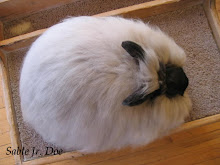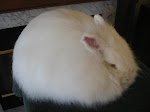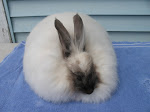--This is another post from the old blog that seemed timely since many parts of the country are experiencing hotter weather than usual right now much earlier in the year. It is important to remember that the first heat wave of the summer (or spring) is the most dangerous, and that the most vulnerable members of your herd will always be the pregnant and lactating does. Here in NY our temperatures reached 92 today and I spent the day at home running fans, running ice bottles back and forth, and just generally keeping an eye on everyone for signs of stress. Best of luck to those of you who are experiencing early high temps, and hopefully the weather will revert back to it's normal range soon:-).
August is the month here in NY where we can typically expect the hottest weather. Though the trend has varied somewhat in recent years, the general pattern is 2 weeks or so above 90, and most of that time falls in the month of August.
Since the rabbits' least favorite time of year is here, it seems like a good week to review ways of keeping them cool in the summer months. There are lots of other excellent ideas for summer bunny care out there, but here are just a few that I have tried or used in my rabbitry that seem to provide effective relief:
1) Always, always have an emergency supply of ice bottles in your freezer, starting with the month you can typically expect the highest temps to hit your area. Any type of plastic bottle will do, but the best kind seems to be the 2L soda bottles filled 1/2-3/4 with water and frozen. The round shape of a soda bottle discourages bunnies from chewing on them because they can't get a grip on the plastic, and the larger size bottle keeps it frozen longer. On extremely hot days I can expect a frozen 2L bottle to stay cold for 2 hours, and on cooler days it will last longer, or you won't have to use one at all.
2) Frozen ceramic floor tiles can be effectively used to keep bunnies cool. Plain tiles are inexpensive and easy to get at Lowe's or Home Depot, but it is important to purchase the kind that has a rough surface so that the rabbits don't slip when they become wet with condensation. The advantage of ceramic tiles is that they are easy to stack in the freezer, are not easily chewed, and are convenient for a bunny to sit and lay on top of. The disadvantage of tiles is that they defrost relatively quickly (much faster than ice bottles), and if you want to use them all day you will need several in storage for each rabbit, which can be tedious in large herds.
3) Keep fans in your rabbitry. Depending on the size of your barn, be sure to have enough fans installed on every side to keep air moving throughout the building, but be certain that they are never pointed DIRECTLY at the rabbits to create a draft. In my rabbitry I have 2 industrial sized fans positioned on each end of the building, and they are pointed to blow BETWEEN the cage aisles, so that rabbits can lay against the fronts of their cages to catch a breeze if they need one, but move over to get out of the draft entirely, too. Fans may be positioned on ceilings, in corners, in walls, or anywhere that they are deemed feasible in a rabbitry setup. While it is true that a fan cannot change the actual temperature of a rabbitry, they WILL provide vital air movement that may mean the difference between life and death for many rabbits, particularly Angoras in coat, pregnant does, and does with litters. One way that I have heard of to use fans to bring temperatures down is to hang bags or empty milk jugs full of ice directly in front of the fans so that the air being forced out is cooled. Again, this will require a large store of ice in your freezer and might not last that long depending on temperature.
4) Try not to bother your rabbits during the hottest times of the day. While it is important to keep close tabs on how everyone is handling the heat, it is best to do any maintenance, cleaning, or other work early in the morning or late in the evening when temps are cooler and the herd is not as stressed. Rabbits are most active at dawn and dusk, but on hot days in particular they will lay stretched out on their stomachs in order to expel heat, and keep still and quiet in every other way (again, in order to remain cool and stress free). Do not disturb them aside from regular checks at these times unless it is absolutely necessary, and once the weather has cooled off they will get up and go back to their normal activities.
5) Water on the ears. Another way to cool a bunny off quickly is to spray it's ears with water during the day. Since rabbit regulate their body temperature through their ears, cooling this part of the body will provide instantaneous relief. A spray bottle works well as long as you try not to get water directly into the ear canal, and I have also taken a bowl of cold water outside with a washcloth and soaked the bunny down by holding a cold, wet cloth around both ears for several minutes. Even the jumpy bunnies rarely mind this since it brings such relief, and some even come to the door for immediate attention as soon as I come in with the bowl:).
6) Learn what the hottest time of the day is for your area and concentrate your cooling strategies into this timespan. In my area and where my barn is situated the worst time of day is 4-5PM when the temperature and humidity inside the building absolutely peaks. This is the time I head out with ice bottles,washcloths, and cold water.
7) Water the herd in the evening. After a hot day, fill water bottles and dishes with very cold water and Acid Pak for relief and rejuvenation overnight.
8) Keep some clean cages or carriers inside the house where it is air conditioned or at least very cool (like in the basement, etc). For the hottest days when you have no choice but to move them indoors, it is important to have housing set aside for rabbits who are on the verge of overheating. Here in NY last summer we had temperatures in excess of 100 degrees several days in a row while I was growing out litters and putting on show coats, so every day I spent 2 hours in the morning bringing rabbits inside and setting them up in carriers, and 2 hours at night bringing them out again:(. It was extremely tedious and I didn't look forward to doing it, but it was critical at the time in order to keep everyone alive and eating:(. Whether you need it or not, it is a good idea to have some sort of setup on standby in the house, just in case.
7) Do not allow Angoras to grow full coats in the summer. Unless there is an important show coming up in the Fall and wool growth must begin in July/August or you have a business that requires yields all year round, there is no reason to force an Angora to hold 5-10 inch coats in the heat of the summer. There are few if any shows held at this time of year in most areas due to the risks involved, so it is usually safe to keep most of the herd shaved, clipped, or plucked down during the hottest months, particularly if you have does who are pregnant or nursing, or bucks that have to stay cool in order to remain viable. The only rabbits I have in coat (early coat) at this time of year are rabbits who will show in the Fall, but everyone else gets sheared to the skin at the beginning of each month until the temperatures go down again.
8) Reserve your bottom cages for breeding bucks, pregnant and nursing does, and rabbits who are in coat. Since heat rises, it is always a good idea to house the most valuable rabbits down low in the summer, and high in the winter. If you have stacking cages this is easy to do, if you have single rows then it doesn't apply and everyone must remain at the same level. I also put newly weaned babies into bottom cages in the summer to lessen the stress on their delicate systems and to keep baby ears from growing too quickly and lopping in the heat.
9) Shade. If you are able to do it, try to make sure that your rabbitry is located in a shady part of your property, or at least someplace where there is shade over the building during the hottest part of the day. If your rabbitry is freestanding, plant trees, vines (non-poisonous) and other shrubs nearby to provide shade and keep the interior of the rabbitry cooler.
10) Reserve grooming for the coolest part of the day. This is a no brainer, I think, but unfortunately there are people who don't consider this and insist on dragging animals out at all times of the day for grooming, carrying, exercise, and other activity when it is all that the rabbit can do to stay alive under such handling. While it is good to keep a herd that is not coddled, it is also important to recognize the biological limitations of rabbits in the heat. While they are able to acclimate to warmer climates to some extent, rabbits (and Angoras in particular) CANNOT withstand prolonged periods of heat without proper housing/ help/ and intervention from their owners, and this fact has nothing to do with genetic predisposition
Saturday, April 25, 2009
Subscribe to:
Post Comments (Atom)























No comments:
Post a Comment